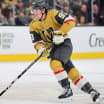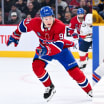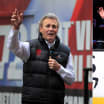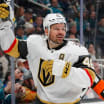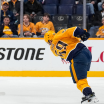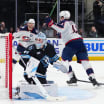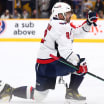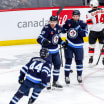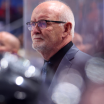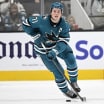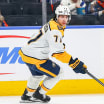The Coaches Room is a weekly column by one of four former NHL coaches and assistants who will turn their critical gaze to the game and explain it through the lens of a teacher. Jim Corsi, David Marcoux, Paul MacLean and Joe Mullen will take turns providing insight.
In this edition, Corsi, the former goaltending coach of the Buffalo Sabres and St. Louis Blues, looks at how goaltending and team defense have evolved and why it's so important the goalie and the players in front of him work together to defend the unscripted ways teams are scoring.
Goaltenders need skill sets that coordinate with team defense
Corsi says chemistry is key to shutting down unscripted scoring chances
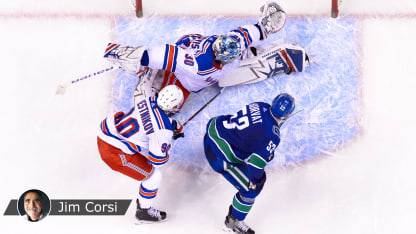
By
Jim Corsi / Special to NHL.com
I recently spoke to Boston Bruins goaltending coach Bob Essensa and Dallas Stars goaltending coach Jeff Reese in what was almost a roundtable discussion about goaltending and team defense and how they have evolved to work in concert with one another.
One of the things that came up in the discussion was how goalies' skill sets have evolved.
If you recall,
Dominik Hasek
used to have a paddle-down, one-knee-down, one-knee-up style. I labeled him a one-knee-down type of player. Now it's called the VH, or vertical horizontal. The other one now is the reverse VH, where one knee on the post is down and the other one is off to the side, so it's a reverse VH. I used to call it post-lean. It's about how the butterfly has evolved into two other techniques to block the net.
We also talked about what teams are dealing with as they try to defend. These are things related to net accessibility, like pucks going to the paint at the goalie's feet, players hunting loose pucks and creating rebounds, players funneling pucks to the net, as well as the philosophy of inside the dots you shoot for yourself and outside the dots you shoot for your friends.
The response has been blocking access to the net, and goalies and players are working together to make it happen.
Goalies nowadays are doomed if they think they're just going to be puck-stoppers, because they're never fast enough to catch up to the play. They have to play within the play, ahead of the play, and they need to work off their defense to do that.
So how do they make it work?
For starters, look at the players. Armored chest and arms. Built-up gloves. Shot-blocking skates. Thicker thigh boards. Increased pad size. And I'm not talking about the goalie equipment here. I'm talking about armored players.
You get a 5-on-4 and the guy in the high umbrella will take a one-timer and the defenseman will come up to the dot, go one knee down sideways and just block the shot. That's fearless. Indeed, they're better protected, but the players do it and it's expected of them to do it.
As a result, players are blocking one half of the shot lane so the goalie has the other half of the shot lane. So instead of a whole net to shoot at, you have half the net and goalies and defensemen are working together to say, 'Well, I've got my half and you've got your half, so we're covered.' That's the counter to the chaos: limiting the access to the net.
You also have players making skate saves now too. Goalies don't make skate saves anymore. A goalie's skate is not nearly as protected as a player's skate now. It really isn't.
However, because it's harder to get shots through these warriors, it leaves more opportunities for deflections and rebounds that go off players instead of the goalie. As a result, goalies have had to develop new blocking skills that allow them more access to rebounds. They have to block the net then track and react to the loose change (i.e. rebounds or loose pucks).
Goalies are blockers when the action is inside the hash marks, but they're able to explode out of the VH or the reverse VH to attack loose pucks. Athleticism is essential; goalies can't have one skill set that defines them anymore.
How many goalies can you say now are true butterfly goalies? Maybe one or two at most. Can you give a defining attribute to goalies like Pekka Rinne (Nashville Predators), Andrei Vasilevskiy (Tampa Bay Lightning), Henrik Lundqvist (New York Rangers), Jonathan Quick (Los Angeles Kings) or Sergei Bobrovsky (Columbus Blue Jackets)?
No.
Goalies need a system of skill sets that work in concert with the team defense. It takes time to develop.
A good example is what's going on with Lundqvist and the Rangers.
For the longest time, Lundqvist played with the same guys in front of him. He knew what they were going to do and they had chemistry. They worked well together and they had a lot of success together.
It's different for him now because of all the changes in New York and it has created a need for an adjustment because of how he still needs work in concert with the defensemen. Lundqvist is working on figuring out how to play with the defensemen, their strengths, communication.
Trading for goalies is precarious in the short term because goalies need more time for synchronicity with their new defensemen and D-zone system. It takes time to develop that because when you talk about goaltending now, you're talking about team defense.
Team defense is structured with defined assignments to make this work. It has to be flexible enough to react to the modern offense. You can't be out of position and running around, but you have to understand it's very much a fearless, read-and-react defense to an unpredictable O-zone attack.
But in the end, team defense starts with your goaltender, because if they hadn't developed the new techniques, we'd be seeing even more scoring. Goaltending continues to get better and evolve. They apply a goaltending system that ultimately includes better application of the new skills as part of team defense. Indeed, top goalies think like players but play like goalies.

